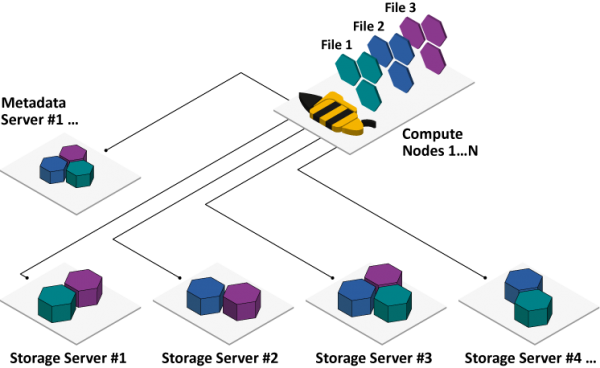Key Aspects of BeeGFS
BeeGFS transparently spreads user data across multiple servers. By increasing the number of servers and disks in the system, you can simply scale performance and capacity of the file system to the level that you need, seamlessly from small clusters up to enterprise-class systems with thousands of nodes.
Distributed File Contents and Metadata
One of the most fundamental advantages of BeeGFS is the strict avoidance of architectural bottlenecks or locking situations in the cluster, through the user space architecture.
This concept allows to scale non-disruptive and linear on metadata & the storage level. Learn More!
HPC Technologies
BeeGFS is built on highly efficient and scalable multithreaded core components with native RDMA support. File system nodes can serve RDMA (InfiniBand, (Omni-Path), RoCE and TCP/IP) network connections at the same time and automatically switch to a redundant connection path in case any of them fails.
Easy to Use
BeeGFS requires no kernel patches (the client is a patchless kernel module, the server components are user space daemons), it comes with graphical Grafana dashboards and allows to add more clients and servers to a productive system whenever required.
Comprehensive Monitoring
BeeGFS now offers systemwide monitoring capabilities, allowing you to easily monitor the performance and health of your BeeGFS system. With the inclusion of Grafana dashboards, you can visualize and analyze the collected data to gain valuable insights into the system’s behavior and optimize its performance.
Optimized for Highly Concurrent Access
Simple remote file systems like NFS do not only have serious performance problems in case of highly concurrent access, they can even corrupt data when multiple clients write to the same shared file, which is a typical use-case for cluster applications. BeeGFS was specifically designed with such use-cases in mind to deliver optimal robustness and performance in situations of any high I/O loads or pattern.
Client and Server on any Machine
No specific enterprise Linux distribution or other special environment is required to run BeeGFS. It uses existing partitions, formatted with any of the standard Linux file systems, e.g., XFS, ext4 or ZFS, which allows different use cases. Learn More!
Wide Linux Distribution and Kernel Support
BeeGFS ensures compatibility with all the latest Linux distributions and kernels. This flexibility enables you to seamlessly integrate BeeGFS into your existing infrastructure without worrying about compatibility issues. BeeGFS is designed to work reliably across a wide range of Linux environments.


